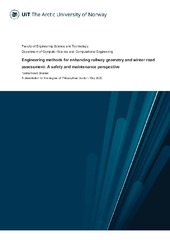| dc.contributor.advisor | Garcia, Odd Erik | |
| dc.contributor.advisor | Decristoforo, Gregor | |
| dc.contributor.advisor | Held, Markus | |
| dc.contributor.author | Jäntti, Henrik | |
| dc.date.accessioned | 2022-06-14T05:32:49Z | |
| dc.date.available | 2022-06-14T05:32:49Z | |
| dc.date.issued | 2022-05-15 | en |
| dc.description.abstract | Numerical simulations of reduced fluid models describing magnetized plasmas have previously been used to study the boundary of fusion plasmas extensively. A common approximation applied to these models is the so-called Boussinesq approximation. One of the requirements for the Boussinesq approximation to be applicable is that the background particle density is significantly higher than the fluctuations in the particle density. Experimental measurements have revealed that at least in the scrape-off layer (SOL) this is not the case, we will therefore investigate the effects of the Boussinesq approximation in this thesis. In addition to this, we also investigate the effects of linearizing the logarithmic density in the drift wave term of the models. To do this we derive four sets of reduced fluid equations describing the edge and SOL regions of a tokamak plasma, one for each combination of approximations. These models are then simulated numerically using the BOUT++ framework. Single point time-series measurements from the simulations are then analysed using the stochastic filtered Poisson process in addition to conventional statistical methods. From the analysis, we observe that there are noticeable differences between the different models, where the largest difference appears when the Boussinesq approximation is used. We found that the logarithmic particle density in the drift wave term generated increased shear flow in the edge region increasing the confinement of plasma to the edge region reducing the overall particle density in the SOL. By relaxing the Boussinesq approximation we observed that structures moving radially outward through the domain have smaller sizes and that the structures in the Boussinesq approximated case, and that these structures decrease in size at faster rates. This indicates that the use of the Boussinesq approximation influences the results of numerical simulation, and deeper studies into the differences between the two cases need to be done. | en_US |
| dc.identifier.uri | https://hdl.handle.net/10037/25462 | |
| dc.language.iso | eng | en_US |
| dc.publisher | UiT Norges arktiske universitet | no |
| dc.publisher | UiT The Arctic University of Norway | en |
| dc.rights.holder | Copyright 2022 The Author(s) | |
| dc.rights.uri | https://creativecommons.org/licenses/by-nc-sa/4.0 | en_US |
| dc.rights | Attribution-NonCommercial-ShareAlike 4.0 International (CC BY-NC-SA 4.0) | en_US |
| dc.subject.courseID | FYS-3900 | |
| dc.subject | VDP::Mathematics and natural science: 400::Physics: 430::Space and plasma physics: 437 | en_US |
| dc.subject | VDP::Matematikk og Naturvitenskap: 400::Fysikk: 430::Rom- og plasmafysikk: 437 | en_US |
| dc.subject | VDP::Mathematics and natural science: 400::Information and communication science: 420::Simulation, visualization, signal processing, image processing: 429 | en_US |
| dc.subject | VDP::Matematikk og Naturvitenskap: 400::Informasjons- og kommunikasjonsvitenskap: 420::Simulering, visualisering, signalbehandling, bildeanalyse: 429 | en_US |
| dc.subject | VDP::Mathematics and natural science: 400::Mathematics: 410::Applied mathematics: 413 | en_US |
| dc.subject | VDP::Matematikk og Naturvitenskap: 400::Matematikk: 410::Anvendt matematikk: 413 | en_US |
| dc.title | Numerical Simulations of Turbulence at the Boundary of Fusion Plasma | en_US |
| dc.type | Mastergradsoppgave | no |
| dc.type | Master thesis | en |


 English
English norsk
norsk



